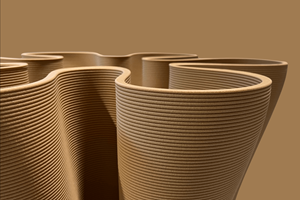DLR closes the loop in fiber-reinforced 3D printing with EmpowerAX, SchallFTP projects
Building on its work in EmpowerAX, the DLR and partners now aim to create a standardized, certifiable value chain that turns fiber waste into consistently reinforced thermoplastic filaments for 3D printing.
Source (All Images) | DLR
At the EmpowerAX InnovationLab, the DLR Institute of Lightweight Systems (Braunschweig, Germany) has worked together with partners from research and industry domains to explore how additive extrusion with continuous fiber reinforcement can be industrialized across various application areas — from aerospace to mobility. The focus has been on the entire process chain, from filament production and printing to the functionally integrated lightweight structure. CW published an overview of the EmpowerAX open platform in 2023.
Building directly on these findings, DLR is actively pursuing the SchallFTP project, which aims to apply a sonic infusion cell for the impregnation and manufacture of fiber-reinforced thermoplastic semi-finished products — such as filaments — in an industrial context. A key area of the project is the advancement of circular economy principles within additive manufacturing. Central to this is the question of how fiber waste can be transformed into new, pseudo continuously reinforced 3D printing filaments in a resource-efficient, cost-effective way with strong application potential.
One thing is clear: carbon fiber-reinforced plastics (CFRP) retain significant material value, even at the end of their service life. Landfilling such materials is not only environmentally questionable but also heavily restricted by EU legislation (1999/31/EC). Against this backdrop, DLR is developing a process within the SchallFTP project that will enable efficient recycling of production waste and reject components into high-quality filaments for fiber-reinforced 3D printing.
Comparison of strengths of vCF- and rCF-based filaments.
To achieve this, carbon fibers coming from production rejects and waste (rCF) are combined with high-performance thermoplastics (such as PPS) through a specially adapted impregnation process. This in-house method enables a fiber volume content of up to 50%, while maintaining minimal degradation, thus making the recycled fibers viable for industrial use. The resulting filaments offer comparable design freedom to those made with virgin carbon fibers (vCF), while significantly reducing both costs and resource consumption, the DLR reports. This makes them particularly attractive for non-load-bearing applications in aerospace, automotive and other mobility sectors, ranging from cabin components to structural parts in vehicle construction.

Illustration on the subject of rCF.
The DLR’s goal is to preserve the material value of rCF as much as possible, closing the loop in lightweight construction in a truly sustainable way. Future research will focus on the reliable processing of different recyclates, particularly regarding fiber quality, contamination and ageing. The objective is to establish robust, industry-ready processes that enable reproducible transformation of recycled fibers into new semi-finished products from filament to functional structure.
Thermoplastic matrix systems also play a key role here. Targeted use of these materials is expected to simplify and accelerate recycling processes. Supported by simulation methods and new quality standards, these efforts aim to boost industry confidence in the use of recycled fibers. In the long term, the DLR seeks to work closely with material producers and application industries to create a standardized, certifiable value chain for rCF-based products.
Insights into the latest developments in high-performance fiber recycling will be presented at the annual on Oct. 8, 2025 in Stade, Germany. The topic will be showcased as one of many exciting research focal points. Participating researchers look forward to engaging directly with attendees and jointly discussing the next steps toward a sustainable, circular fiber-processing future.
Related Content
Sulapac introduces Sulapac Flow 1.7 to replace PLA, ABS and PP in FDM, FGF
Available as filament and granules for extrusion, new wood composite matches properties yet is compostable, eliminates microplastics and reduces carbon footprint.
Read MoreRevisiting the OceanGate Titan disaster
A year has passed since the tragic loss of the Titan submersible that claimed the lives of five people. What lessons have been learned from the disaster?
Read MorePlant tour: Collins Aerospace, Riverside, Calif., U.S. and Almere, Netherlands
Composite Tier 1’s long history, acquisition of stamped parts pioneer Dutch Thermoplastic Components, advances roadmap for growth in thermoplastic composite parts.
Read MoreInfinite Composites: Type V tanks for space, hydrogen, automotive and more
After a decade of proving its linerless, weight-saving composite tanks with NASA and more than 30 aerospace companies, this CryoSphere pioneer is scaling for growth in commercial space and sustainable transportation on Earth.
Read MoreRead Next
DLR study considers cast PA6 molds for in situ AFP composites
3D printed thermoplastic mold was analyzed as alternative to expensive, time-consuming metallic molds and for suitability in aerospace-grade composite structure fabrication.
Read MoreInterfacial, CEAD launch strategic LFAM partnership
With the help of CEAD, Interfacial closes the gap between formulation and production-ready solutions made from 3D printed thermoplastic materials and functional composites.
Read MoreNext-gen fan blades: Hybrid twin RTM, printed sensors, laser shock disassembly
MORPHO project demonstrates blade with 20% faster RTM cure cycle, uses AI-based monitoring for improved maintenance/life cycle management and proves laser shock disassembly for recycling.
Read More












